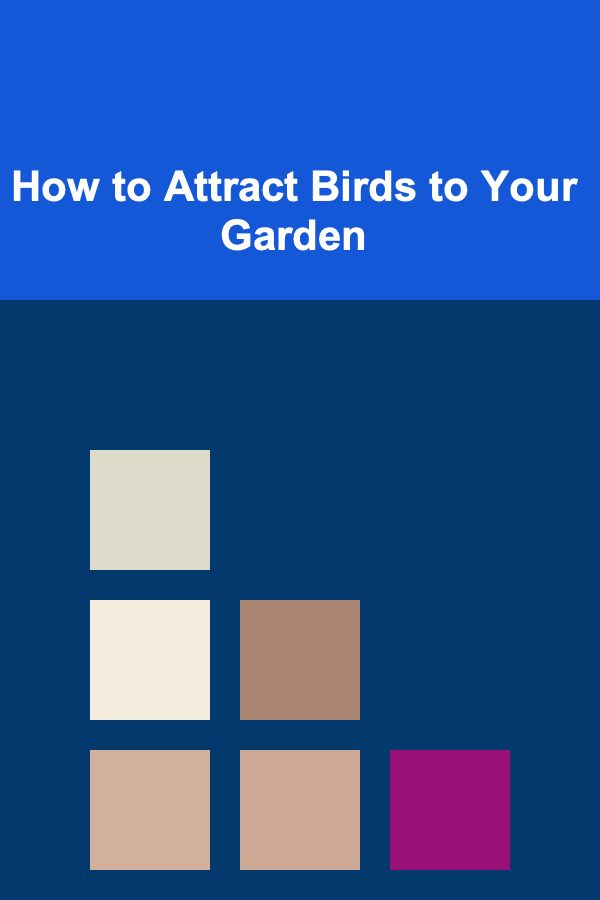
How to Attract Birds to Your Garden
ebook include PDF & Audio bundle (Micro Guide)
$12.99$6.99
Limited Time Offer! Order within the next:

Attracting birds to your garden can transform an ordinary space into a vibrant, lively environment filled with natural beauty. The presence of birds not only enhances the aesthetics of your garden but also benefits the ecosystem by helping with pest control, pollination, and seed dispersal. Creating a bird-friendly garden is a rewarding endeavor, requiring thoughtful planning and a combination of strategies. In this article, we will explore the most effective ways to attract birds to your garden, considering everything from the types of plants and feeders you use to the broader ecological factors that play a role in attracting avian visitors.
Understanding Bird Preferences
Before diving into specific strategies, it's essential to understand what birds need and prefer when choosing a garden. Birds are drawn to gardens that provide food, water, shelter, and nesting opportunities. Each species of bird has different needs and preferences, but some common factors can guide your efforts in creating a bird-friendly garden.
1. Food: Birds are primarily attracted to gardens that offer a diverse range of food sources. This includes seeds, fruits, nectar, insects, and even small animals. By offering a variety of food options, you can attract different species, from seed-eaters like sparrows and finches to insect-eaters like warblers and woodpeckers.
2. Water: Water is crucial for birds, not only for drinking but also for bathing. A reliable water source can be the deciding factor for attracting birds to your garden, particularly during the warmer months when natural water sources may be scarce.
3. Shelter: Birds need safe spaces to rest and hide from predators. Trees, shrubs, and even man-made structures like birdhouses can provide the shelter birds need. Dense foliage offers cover from predators, while taller trees provide perching spots for species like hawks and eagles.
4. Nesting Sites: Offering appropriate nesting sites is essential for encouraging birds to settle in your garden. Depending on the species, birds may require different types of nesting boxes, trees, or shrubs for safe and secure nesting.
By considering these key factors and incorporating them into your garden design, you can create an inviting space for birds.
Designing a Bird-Friendly Garden
Creating a bird-friendly garden requires more than just adding a bird feeder to your backyard. A successful garden for birds will include a mix of plants, structures, and features that meet their diverse needs. Here are some detailed steps to help you design a bird-friendly space.
1. Plant Native Plants
The most important step in attracting birds to your garden is choosing the right plants. Native plants are specifically adapted to the local climate and environment, making them a great choice for supporting local wildlife. Many birds rely on native plants for food, shelter, and nesting sites.
Benefits of Native Plants:
- Food sources: Native plants produce seeds, fruits, and berries that local birds can feed on. For example, the American Robin is attracted to holly and juniper bushes for their berries.
- Insect attraction: Native plants also attract insects, which are an essential food source for many birds, particularly insectivorous species like swallows and wrens.
- Natural habitat: Native plants provide the appropriate shelter and nesting sites for local birds. Some species, such as the Eastern Bluebird, prefer nesting in old, hollow trees, which can be replaced with native shrubs and trees that have similar features.
Consider planting a mix of native trees, shrubs, flowers, and grasses to create a diverse environment. Some examples of bird-friendly native plants in North America include:
- Sunflower (Helianthus spp.)
- Echinacea (Echinacea purpurea)
- Goldenrod (Solidago spp.)
- Serviceberry (Amelanchier spp.)
- Red-twig dogwood (Cornus sericea)
By offering a variety of plants, you can attract different bird species throughout the year.
2. Create Layers of Habitat
A layered garden structure provides birds with more opportunities for shelter, food, and nesting. Layering refers to creating different levels in your garden, such as ground cover, low shrubs, mid-sized shrubs or small trees, and tall trees. Each layer serves a unique purpose for different types of birds.
- Ground cover: Birds like sparrows and ground doves feed on seeds found on the ground. By planting low-growing grasses or clovers, you create a food source for these birds.
- Shrubs: Mid-sized shrubs provide cover for smaller birds, like finches and warblers, which need shelter from predators. These shrubs also offer berries and insects.
- Tall trees: Larger trees, such as oaks or maples, are favored by birds like woodpeckers, hawks, and owls for both shelter and nesting. Tall trees provide places for perching, roosting, and protection.
Incorporating a mix of low, medium, and tall vegetation will create a multi-layered habitat, allowing different species to thrive.
3. Install Bird Feeders
One of the most straightforward ways to attract birds to your garden is by installing bird feeders. Feeders provide a steady food source, especially during the colder months when natural food may be scarce.
Types of Feeders:
- Tube feeders: These are ideal for smaller birds, such as finches, chickadees, and sparrows. They allow birds to feed on seeds like sunflower, safflower, or thistle without worrying about larger animals like squirrels accessing the food.
- Platform feeders: These flat, open feeders are perfect for ground-feeding birds like juncos, mourning doves, and starlings. Platform feeders can be stocked with a variety of seeds and attract a wide range of species.
- Hopper feeders: These are suitable for a variety of birds, from cardinals to blue jays. They typically hold larger amounts of seed and can be designed with a roof to keep the food dry.
- Suet feeders: Suet is a high-energy food source for birds like woodpeckers, nuthatches, and chickadees. Suet feeders can be a block of suet or a cage that holds suet cakes.
It's important to choose the right type of seed for the birds you're hoping to attract. Black oil sunflower seeds are popular among many species, while thistle (nyjer) seeds are particularly attractive to finches. Avoid seed blends that contain a lot of fillers like millet or cracked corn, as these often go uneaten and create waste.
4. Provide Fresh Water
Birds need a reliable water source for drinking and bathing. Having a water feature in your garden is one of the best ways to attract birds. A birdbath is an easy option, but a small pond or even a water fountain can be more effective at drawing in a diverse range of birds.
Tips for Water Features:
- Shallow water: Birds prefer shallow water, as it allows them to drink and bathe safely. Ensure that the water is no more than 2-3 inches deep.
- Moving water: Birds are naturally drawn to the sound of running water. A birdbath with a built-in fountain or a small, gently moving stream can attract even more birds.
- Clean regularly: Stagnant, dirty water can be a breeding ground for bacteria and mosquitoes. Clean your birdbath or water feature regularly to ensure the water remains fresh and safe for the birds.
5. Provide Nesting Boxes
If you want to encourage birds to stay in your garden, consider providing nesting boxes. These can be placed in trees, on poles, or attached to structures like fences or walls.
Different bird species require different types of nesting boxes, so it's important to choose one that suits the needs of the birds in your area. For example:
- Eastern Bluebirds prefer a specific size and shape of nesting box with a 1.5-inch entrance hole.
- Tree Swallows need a small, enclosed cavity.
- Chickadees require a nesting box with a hole of around 1.25 inches in diameter.
By installing nesting boxes, you can help create a safe environment for birds to raise their young, especially in urban areas where natural nesting sites may be limited.
6. Minimize Lawn Areas
Lawns may seem like a pristine addition to a garden, but they don't provide much in terms of food, shelter, or nesting sites for birds. Large, manicured lawns are often devoid of the insects and plants that birds need to survive. Consider replacing some of your lawn with native plantings, wildflowers, or ground cover that can attract insects, providing food for birds.
Additionally, reducing your lawn size can benefit local wildlife by promoting biodiversity and creating a more natural habitat.
Conclusion
Attracting birds to your garden is a process that requires patience, dedication, and a thoughtful approach to creating a welcoming environment. By planting native plants, installing feeders, providing water, and offering nesting sites, you can create a thriving habitat that supports a wide variety of bird species. The benefits of having birds in your garden extend beyond mere beauty -- they contribute to the health of your local ecosystem by controlling pests, pollinating plants, and dispersing seeds.
Creating a bird-friendly garden is not only a way to enjoy nature up close, but it also fosters a sense of connection to the environment and the creatures that share it. By providing the right resources and making small changes to your landscape, you can help ensure that birds continue to thrive in your backyard for years to come.

How to Generate Income by Selling Pre-Trained Deep Learning Models
Read More
How to Make Money Online as a Graphic Designer: 10 Actionable Ideas
Read More
How to Protect Your Pet from Seasonal Allergies
Read More
How to Get International Health Insurance
Read More
How to Track Variable Expenses for Debt Payoff
Read More
How to Design Your Own Cross-Stitch Patterns for Beginners
Read MoreOther Products

How to Generate Income by Selling Pre-Trained Deep Learning Models
Read More
How to Make Money Online as a Graphic Designer: 10 Actionable Ideas
Read More
How to Protect Your Pet from Seasonal Allergies
Read More
How to Get International Health Insurance
Read More
How to Track Variable Expenses for Debt Payoff
Read More